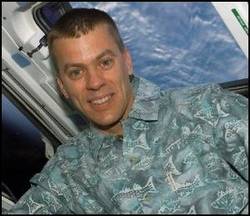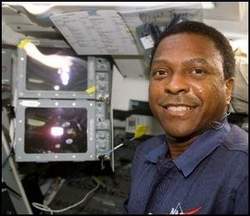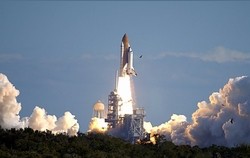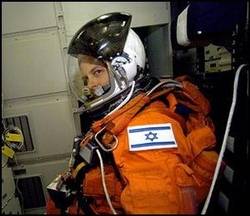Meet the Astronauts:
STS-107 MCC Status Report #01; Thursday, Jan. 16, 2003 - 10
a.m. CST
 Columbia lifted off from the Kennedy Space
Center this morning on the first shuttle mission of the year,
carrying the first Israeli astronaut into orbit along with six
crewmates on a marathon international scientific research
flight.
Columbia lifted off from the Kennedy Space
Center this morning on the first shuttle mission of the year,
carrying the first Israeli astronaut into orbit along with six
crewmates on a marathon international scientific research
flight.
Commander Rick Husband, Pilot Willie McCool (right), Mission
Specialists Dave Brown, Kalpana Chawla and Laurel Clark, Payload
Commander Mike Anderson and Payload Specialist Ilan Ramon of the
Israel Space Agency blasted off at 9:39 a.m. CST from Launch Pad
39-A. Less than nine minutes later, Columbia settled into
an orbit inclined 39 degrees to the equator.
 ...Aboard Columbia more than 80
experiments dealing with astronaut health and safety, advanced
tehnology development and Earth and space sciences.
...Aboard Columbia more than 80
experiments dealing with astronaut health and safety, advanced
tehnology development and Earth and space sciences.
Husband, Chawla (right), Clark and Ramon comprise the Red team
which will work in the pre-dawn and daytime hours, while McCool,
Brown and Anderson make up the Blue team, working the evening
and overnight hours...
 Having shifted their sleep schedule to accommodate
the dual-shift operations, McCool, Brown and Anderson (right) will
begin an abbreviated six-hour sleep period at 1:39 p.m. CST and
will be awakened at 7:39 p.m. while Red team counterparts continue
the early stages of experiment activation.
Having shifted their sleep schedule to accommodate
the dual-shift operations, McCool, Brown and Anderson (right) will
begin an abbreviated six-hour sleep period at 1:39 p.m. CST and
will be awakened at 7:39 p.m. while Red team counterparts continue
the early stages of experiment activation.
Husband, Chawla, Clark and Ramon will begin an eight-hour sleep
period at 8:39 p.m. and will be awakened Friday at 4:39 a.m. to
handover work from the Blue team which will be continuing the
initial phase of scientific studies overnight...
STS-107 MCC Status Report #02; Thursday, Jan. 16, 2003 –
4:30 p.m. CST
Columbia's crewmembers unstowed equipment and began activation
of the Spacehab Research Double Module in the shuttle's cargo bay,
setting the stage for 24-hour-a-day science during the shuttle's
16-day research mission...
Spacehab is a pressurized research module 20 feet long, 14 feet
wide and 11 feet high. It houses equipment for 59 experiments,
three of them mounted on its roof. Its activation marks the
beginning of the major science activities of Columbia's
mission...
STS-107 MCC Status Report #03; Friday, Jan. 17, 2003 – 5
p.m. CST
 In their first full day in orbit,
Columbia’s seven crewmembers completed activation of
the Spacehab Research Double Module in the shuttle’s cargo
bay and all of its scientific experiments...
In their first full day in orbit,
Columbia’s seven crewmembers completed activation of
the Spacehab Research Double Module in the shuttle’s cargo
bay and all of its scientific experiments...
All Spacehab payloads are performing well and research
activities continue on schedule. Specific experiment highlights so
far include:
All Fast Reaction Experiments Enabling Science Technology
Applications and Research, or FREESTAR, payloads have been
activated and are performing well. One Freestar experiment that
measures the amount of energy coming from the sun completed an
initial observation, with the best sun pointing ever seen on any
shuttle flight. Another experiment that will perform measurements
of the Earth’s ozone layer is operating nominally. The
Mediterranean Israeli Dust Experiment, or MEIDEX, which will
measure small particles called aerosols in the atmosphere over the
Mediterranean Sea and the Atlantic Ocean off the coast of the
Sahara desert, has been readied for initial observations.
The Bioreactor Demonstration System made its initial run. The
NASA-developed bioreactor is being used to grow prostate cancer
tissues to help scientists better understand how the cancer spreads
into bones and to aid in the development of future treatment
methods. In the first 20 hours of experiment operations, a
significant aggregate of tumor tissue was grown.
The Critical Viscosity of Xenon-2 experiment has been working
nominally. The instrument is cooling the xenon sample to begin
calibration. A preliminary analysis of the flight data compares
favorably with ground-based data. This research in fluid physics
may be important to the production of paints, plastics, drugs, food
and cosmetics...
STS-107 MCC Status Report #04; Saturday, January 18, 2003 -
5:00 p.m. CST
 Space shuttle Columbia's astronauts
pointed two Israeli cameras over the Atlantic and the Mediterranean
today in search of small dust particles that might impact the
weather and began experiments in human life sciences in the third
day of the STS-107 scientific research flight.
Space shuttle Columbia's astronauts
pointed two Israeli cameras over the Atlantic and the Mediterranean
today in search of small dust particles that might impact the
weather and began experiments in human life sciences in the third
day of the STS-107 scientific research flight.
Specific experiment highlights today included:
- A radiometric camera and a video camera were aimed at the
Atlantic and the Mediterranean as part of the Mediterranean Israeli
Dust Experiment. Although no dust was detected due to heavy cloud
coverage, initial analysis showed that the two cameras are working
well, supplying high-quality images. The cloud patterns imaged by
the cameras showed remarkable details. The intent of the experiment
is to help researchers better understand how dust particles in the
atmosphere affect climate.
- An experiment that looks at the movement of calcium through the
body to further understanding of bone loss in space began.
Astronauts took oral calcium tracers that will be monitored over
the course of the mission to examine how calcium metabolism changes
in an astronaut's body during spaceflight.
- In the physical sciences, the second run of the Mechanics of
Granular Materials was completed. The objective of the experiment
is to improve and enhance science and technology in many
disciplines including earthquake engineering and soil mechanics.
Results may lead to answers concerning the consequences of
earthquakes, such as damage to soils and foundations...
STS-107 MCC Status Report #05; Sunday, January 19, 2003 - 4:00
p.m. CST
Columbia's astronauts studied combustion properties and
the response of their own bodies in weightlessness and the behavior
of soot in space one-quarter of the way through their marathon
scientific research mission.
 Red Team members Commander Rick Husband, Mission
Specialists Kalpana Chawla and Laurel Clark (Husband and Clark,
right) and Israeli Payload Specialist Ilan Ramon
(below) completed the first data collection sessions with the
Combustion Module in the Spacehab research module housed in
Columbia's cargo bay. One of three experiments housed in
the Combustion Module --- the study of Laminer Soot Processes (LSP)
--- is designed to gain a better understanding of soot formation,
oxidation and radiative properties within flames.
Red Team members Commander Rick Husband, Mission
Specialists Kalpana Chawla and Laurel Clark (Husband and Clark,
right) and Israeli Payload Specialist Ilan Ramon
(below) completed the first data collection sessions with the
Combustion Module in the Spacehab research module housed in
Columbia's cargo bay. One of three experiments housed in
the Combustion Module --- the study of Laminer Soot Processes (LSP)
--- is designed to gain a better understanding of soot formation,
oxidation and radiative properties within flames.
Additional data were gleaned from the Mechanics of Granular
Materials experiment (MGM) in the Spacehab module, which is
providing information on the behavior of saturated sand when
exposed to confining pressures in microgravity. The experiment
could provide engineers with valuable data for strengthening
buildings against earthquakes.
 Work was also accomplished with a series of
biomedical experiments studying the human body's response to
weightlessness --- particularly dealing with protein manufacturing
in the absence of a gravity environment, bone and calcium
production, the formation of chemicals associated with renal stones
and how saliva and urine change in space relative to any exposure
to viruses.
Work was also accomplished with a series of
biomedical experiments studying the human body's response to
weightlessness --- particularly dealing with protein manufacturing
in the absence of a gravity environment, bone and calcium
production, the formation of chemicals associated with renal stones
and how saliva and urine change in space relative to any exposure
to viruses.
Experiments continued with the MEIDEX cameras in the cargo bay
observing dust storms in the Mediterranean region and with the
SOLSE experiment, geared to studying the amount of ozone in the
Earth's atmosphere by using a special imaging spectrometer in the
payload bay to look across the limb of the Earth during
specifically scheduled orbits...
Just in: STS-107 MCC Status Report #06; Monday, January 20,
2003 - 6:00 p.m. CST
Columbia's astronauts conducted scientific studies ranging from
the behavior of granular materials in weightlessness to the effects
of microgravity on fungi, and filmed the sprites associated with
thunderstorms across the globe as their scientific research flight
continued in its fifth day...
The Red team is working what amounts to the day shift on orbit,
while the Blue team --- Pilot Willie McCool, Mission Specialist
Dave Brown and Payload Commander Mike Anderson --- is working the
overnight shift. The division of the two teams into 12-hour shifts
assures that scientific research is conducted
round-the-clock...
This afternoon, flight controllers observed a minor electrical
current spike in one of two systems designed to collect and
distribute water produced from condensation buildup caused by the
operation of the cooling system in the Spacehab Research Module in
the cargo bay.
An identical system sprung a leak under the floorboards of
Spacehab last night and was shut down. The secondary system had
been operating normally until the electrical spike was observed at
around 1:15 p.m. A plan was implemented to reconfigure a valve in
Columbia, allowing cool air from the shuttle to flow into the
science module, thus enabling the module's temperatures to remain
at a level that will not require the use of Spacehab's cooling
system, while preventing any further buildup of condensation.
Later, an air duct was routed from Columbia to the Spacehab to
increase the flow of cool air into the science facility.
Flight controllers plan to continue their analysis of the
Spacehab cooling issue throughout the night, with no impact
expected to science operations...
 Classic Aero-TV: The Switchblade Flying Car FLIES!
Classic Aero-TV: The Switchblade Flying Car FLIES! ANN FAQ: Q&A 101
ANN FAQ: Q&A 101 ANN's Daily Aero-Term (04.12.24): Discrete Code
ANN's Daily Aero-Term (04.12.24): Discrete Code ANN's Daily Aero-Term (04.13.24): Beyond Visual Line Of Sight (BVLOS)
ANN's Daily Aero-Term (04.13.24): Beyond Visual Line Of Sight (BVLOS) ANN's Daily Aero-Linx (04.13.24)
ANN's Daily Aero-Linx (04.13.24)









